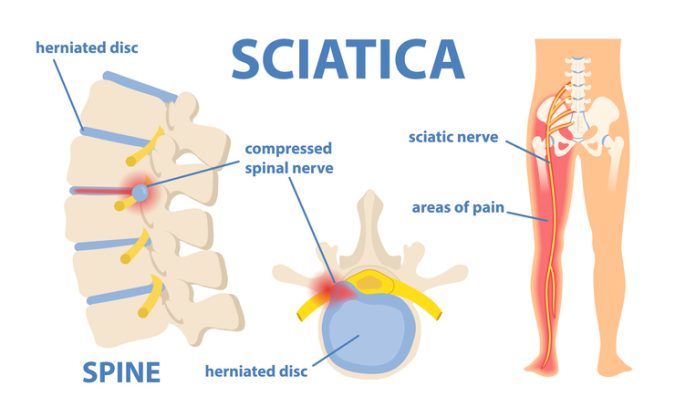Estimated reading time: 0 minutes
Pain that radiates along the path of the sciatic nerve, which travels from your lower spine through your buttocks and down the back of your leg, is referred to as sciatica. It crops up when the sciatic nerve is inflamed or constricted by any of a number of conditions affecting the lower back.
Sciatica is a form of nerve discomfort.
A number of nerve roots emerge from the base of the vertebrae. When any of these nerve roots on either side of the lower spine are inflamed or compressed, the sciatic nerve can become painful. Pain may radiate along the sciatic nerve, into the buttock, down the back of the leg, and/or into the foot and/or digits. It typically affects only one side of the body.
The sensation is distinct and is typically described as a shooting, searing pain in the buttock that radiates down the back of the leg. You may experience paralysis, tingling, or burning along the nerve. Some individuals have compared the nerve distress to an electric shock. Sciatica symptoms, on the other hand, may be experienced as a constant, vague pain.
Sciatica is also known as lumbar radicular pain and lumbar radiculopathy.
Frequent lower back issues that cause sciatica
A herniated lumbar disc is the most common cause of sciatica. Common causes include lumbar spinal stenosis, facet joint osteoarthritis, lumbar degenerative disc disease, and spondylolisthesis.
If the term sciatica is misused, people may be tempted to self-diagnose and self-treat the incorrect cause of their sciatica. Understanding the underlying cause of your sciatica symptoms is crucial in order to receive the proper treatment.
Several conditions resemble sciatica.
Many people refer to any type of leg pain as sciatica, but there are numerous causes of limb pain that are not medically classified as sciatica and require separate treatment.
Examples of conditions besides sciatica that may cause comparable symptoms include:
Spinal joint disorder. The spinal joints may radiate pain to the limb. This is technically not sciatica, and the treatment is distinct. For instance, joint deterioration brought on by spinal arthritis may cause sciatica-like discomfort.
An issue with the sacroiliac joint. Too much or too little motion in the sacroiliac joints can cause pain similar to sciatica that radiates down the leg. The aim of non-surgical treatment for sacroiliac joint dysfunction is to restore normal joint motion. If the pain is severe and incapacitating, fusion of the sacroiliac joint is an option.
The symptoms of Piriformis syndrome are comparable to those of sciatica. It occurs when the piriformis muscle in the buttocks stimulates the sciatic nerve, causing pain to radiate into the limb along the nerve’s path. This form of pain is technically not sciatica because the nerve irritation does not originate in the lower back. Typically, Piriformis syndrome is treated with anti-inflammatory drugs and specialised physical therapy.
It is not advisable to diagnose sciatica on your own.
Due to the fact that numerous underlying conditions can produce sciatic pain, it is essential to seek medical care for a clinical diagnosis. Infrequently, sciatica-like pain can be caused by medical conditions requiring prompt treatment, such as:
Cancer of the spine
Infection of the vertebrae
The Cauda Equina Disorder
Despite the fact that the overwhelming majority of causes of sciatica symptoms are not serious, it is always advisable to consult a physician if you are experiencing concerning symptoms.
If you experience pain in your buttocks or leg, along with numbness, tingling, or other neurological symptoms in your leg, you should consult a physician for a clinical diagnostic to determine the cause of your symptoms.
The peer-reviewed articles on this website will demonstrate that the treatment for your symptoms may vary widely depending on their underlying cause. For example:
While bending forward at the pelvis may be comfortable if you have spinal stenosis, it can be extremely painful if you have a herniated disc in your lumbar region.
Before engaging in any form of exercise, your doctor may recommend fusion surgery to correct and stabilise the affected segment if you have sciatica caused by spondylolisthesis.
Commit to a progressive exercise regimen for long-term pain relief.
When your physician grants you the go-ahead, make a concerted effort to adhere to a progressive and controlled fitness programme. Without it, your symptoms would recur and likely worsen over time.
The use of cold and heat, pain medications, and possibly an epidural steroid injection are all viable options for providing sufficient pain relief to enable exercise and physical therapy. Physical therapists and spinal specialists can devise an exercise-friendly pain-reduction treatment plan.
Related-
Know more about Ayurvedic Spinal Disk & Radiculopathy Treatments.
GET IN TOUCH


Recent comments